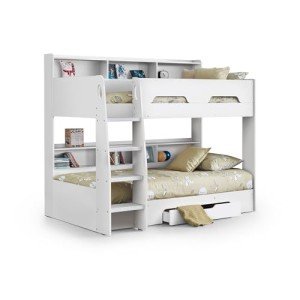An Intermediate Guide For Bunk Beds

Exploring Bunk Beds: A Comprehensive Guide
Bunk beds have actually long been a staple in children's bed rooms, dormitories, and even homes with limited space. Not just do they provide a useful sleeping service, but they also develop an enjoyable and creative environment for children and a great space-saver for adults and families. This short article will explore whatever you need to know about bunk beds, from types and materials to security tips and buying suggestions.
Tabulation
- Kinds Of Bunk Beds
- Standard Bunk Beds
- Loft Beds
- Triple Bunk Beds
- L-Shaped Bunk Beds
- Product Options
- Wood
- Metal
- Security Considerations
- Buying Guide
- Frequently asked questions
Types of Bunk Beds
Bunk beds come in numerous styles to match different requirements and preferences. Here's a breakdown of the most common types:
Conventional Bunk Beds
Conventional bunks normally include two beds stacked vertically on top of one another. visit the following post are perfect for siblings sharing a space or for optimizing sleeping space in visitor rooms.
Loft Beds
Loft beds stand similarly to conventional bunk beds however do not have a lower sleeping area. Instead, they frequently include a desk or seating area beneath, making them a great option for little spaces needing multifunctionality.
Triple Bunk Beds
Triple bunk beds are created for three residents, with beds stacked in a three-tier setup. These are less common but can be a fun solution for large families or sleepovers.
L-Shaped Bunk Beds
With one bed positioned horizontally and the other vertically, L-shaped bunk beds are frequently equipped with extra functions such as desks or storage drawers and can complement corner spaces in a space.
Contrast of Bunk Bed Types
| Bed Type | Ideal Use | Description |
|---|---|---|
| Traditional | Shared bed rooms or guest rooms | Two beds stacked vertically |
| Loft | Small spaces requiring multi-purpose space | Upper bed with open space beneath |
| Triple | Large households or slumber parties | 3 beds stacked vertically |
| L-Shaped | Corner or flexible spaces | A combination of vertical and horizontal beds |
Material Options
Bunk beds are made from numerous products, with wood and metal being the most common. Each product has its pros and cons.
Wood
- Sturdiness: Generally robust and can hold up against years of usage.
- Visual Appeal: Offers a traditional look that can mix with different decorations.
- Weight Capacity: Typically sturdier; can support much heavier weights.
- Downsides: May be more expensive than metal options and can be susceptible to scratches.
Metal
- Toughness: Generally light-weight and easy to move however still durable.
- Modern Design: Often can be found in sleek styles, making it appealing for modern areas.
- Cost-efficient: Usually more economical than wooden choices.
- Downsides: Can be cold to the touch in winter seasons and might not have the exact same visual appeal for some purchasers.
Security Considerations
When it comes to bunk beds, safety can not be neglected. Here are crucial safety pointers to bear in mind:
- Guardrails: Ensure that the top bunk has guardrails on both sides to avoid falls.
- Strong Construction: Check for a strong build and sturdy materials to withstand weight and movement.
- Weight Limit: Adhere to the manufacturer's weight limit for both the upper and lower bunks.
- Ladder Design: Choose bunks with a safe, easy-to-climb ladder and prevent any sharp edges or rungs.
- Age Restrictions: Most manufacturers advise that children under the age of six ought to not sleep in the upper bunk.
Buying Guide
When searching for bunk beds, consider the following aspects to find the very best suitable for your requirements:
- Space Availability: Measure the space size and ceiling height, making sure there is sufficient space for the top bunk.
- Bed Size: Decide in between twin, full, or bigger sizes based upon your needs and the size of the room.
- Design Preference: Consider the overall decoration of the bedroom to find an appropriate design.
- Alleviate of Setup: Look for a bunk bed that is uncomplicated to put together.
- Spending plan: Bunk beds come in various price ranges, so figure out a spending plan before beginning your search.
FAQs
1. What is the suggested age for children to sleep on the top bunk?
Children aged 6 and older are generally suggested to sleep on the top bunk to lessen the danger of falls.
2. How can I make my bunk bed much safer?
To enhance safety, make sure guardrails are correctly set up and examine that the bed is put on a flat surface. In addition, encourage children to use the ladder carefully.
3. Can I convert a bunk bed into 2 different beds?
Numerous bunk beds are designed to be convertible. Check the manufacturer's specs for convertibility functions.
4. What accessories are available for bunk beds?
Typical accessories include bed linens, storage drawers, staircases rather of ladders, and tented canopies for a fun visual appeal.
5. How do I maintain my bunk bed?
Regular checks for loose screws or structural integrity can assist make sure security. Dust the bed routinely and tidy spills quickly to keep the products in good condition.
Bunk beds are flexible and a space-efficient service for different living scenarios, from kids's rooms to guest accommodations. With lots of styles and materials offered, potential buyers have a wealth of options to think about, ensuring a mix of practicality and aesthetic appeals. By prioritizing security and following the tips detailed in this guide, people can find the right bunk bed that matches their space and lifestyle, all while producing an enjoyable sleeping environment.

